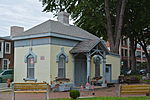Berks station
Railway stations in PhiladelphiaRailway stations in the United States opened in 1922SEPTA Market-Frankford Line stations

Berks station is an elevated rapid transit station on the SEPTA Market–Frankford Line, located at the corner of Front and Berks streets in the Kensington neighborhood of Philadelphia, Pennsylvania. The station is also served by SEPTA bus route 3.
Excerpt from the Wikipedia article Berks station (License: CC BY-SA 3.0, Authors, Images).Berks station
North Front Street, Philadelphia
Geographical coordinates (GPS) Address Nearby Places Show on map
Geographical coordinates (GPS)
| Latitude | Longitude |
|---|---|
| N 39.9787 ° | E -75.1335 ° |
Address
Berks SEPTA MFL Station
North Front Street
19120 Philadelphia
Pennsylvania, United States
Open on Google Maps








